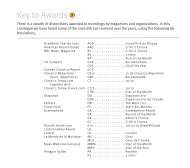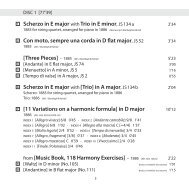MENDELSSOHN - Bis
MENDELSSOHN - Bis
MENDELSSOHN - Bis
Create successful ePaper yourself
Turn your PDF publications into a flip-book with our unique Google optimized e-Paper software.
had been excommunicated in 1521 and declared an outlaw.) Men dels sohn began<br />
work on a ‘Symphony in Com mem oration of the Church Revolu tion’ (as it was<br />
originally called) in late 1829 while he was still in Scot land, and completed the<br />
work on 12th May 1830 – the day before he set off on his grand tour of 1830–32.<br />
The first performance of the ‘Re forma tion’ Sym phony did not take place until<br />
late 1832, however, as the Re formation cel ebra tions of 1830 fell victim to poli -<br />
tical un rest. In Paris, where a further per form ance had been planned, the musi -<br />
cians of the Conservatoire orch estra refused to play the piece and criti cized those<br />
traits that Mendelssohn, for programmatic reasons, had consciously based on an<br />
archaic-sounding stile an tico: ‘too academic, too much fugato, too little melody’.<br />
Mendelssohn later dis tanced himself from this ‘youth ful piece’: in 1838 he wrote<br />
in a letter that ‘of all my pieces, this is the one that I should most like to burn’,<br />
and he obstructed both its performance and its pub lication. The work, which re -<br />
mained ‘im pris oned’ (as the composer himself put it) in his desk drawer, appeared<br />
only after the com poser’s death, which ex plains the sym pho ny’s anachronistic<br />
numbering – 5 instead of 2 – and its high opus number.<br />
As befits a ‘church symphony’, Mendelssohn begins in the traditional ‘church<br />
style’: the slow introduction in D major derives its theme from the Greg orian<br />
Magnificat and culminates mysteriously in a transfigured (Catholic) ‘Dresden<br />
Amen’, a motif later taken up in identical form by Wagner (the grail motif in<br />
Parsifal). After such an intense preparation, the Allegro con fuoco brings the<br />
wind fanfares from the introduction to the fore. In the dramatic development<br />
section the restless, aggressive orchestral activity in creases in contrapuntal com -<br />
plexity until the ‘Dresden Amen’ – a relic from the introduction – brings this<br />
section to an end. With considerably greater reticence the modified recap itulation<br />
now commences, in the course of which the D minor fanfare theme does, how -<br />
ever, rise up again to its former grandeur.<br />
29








